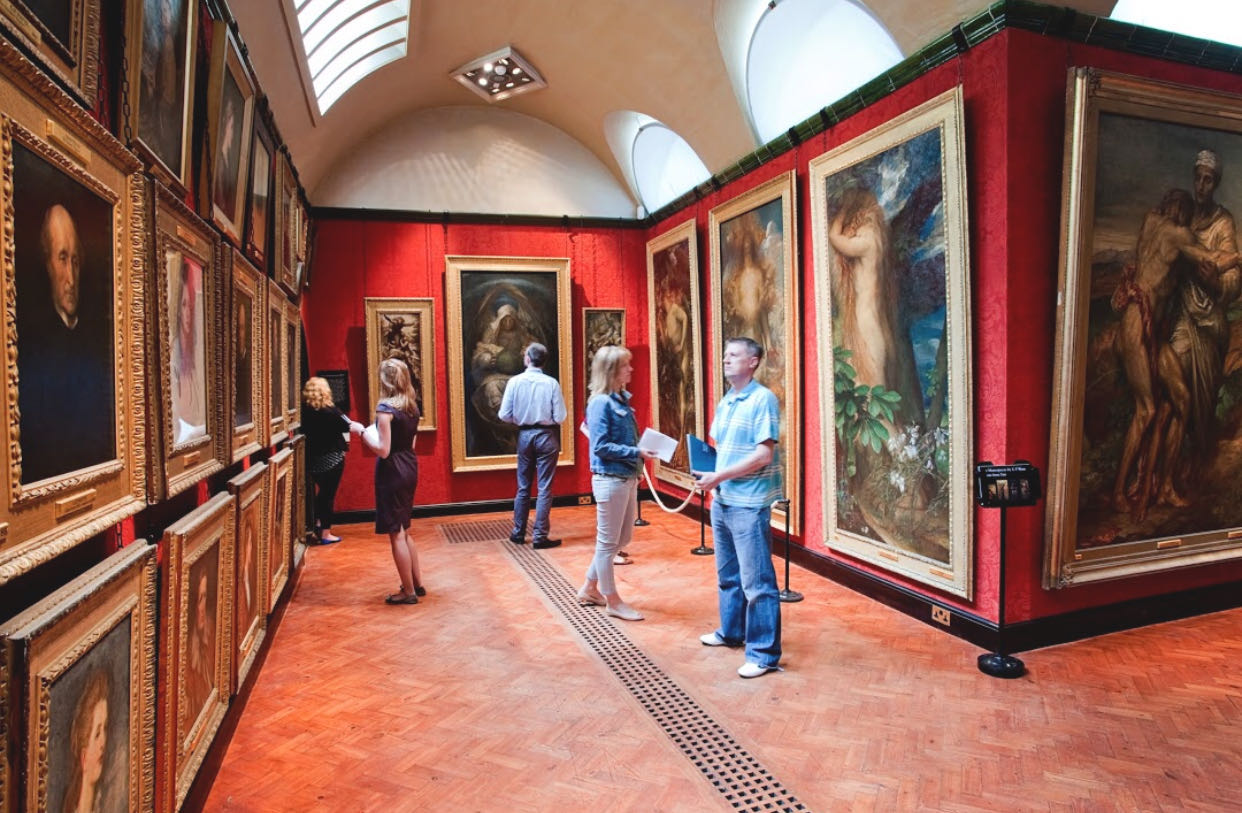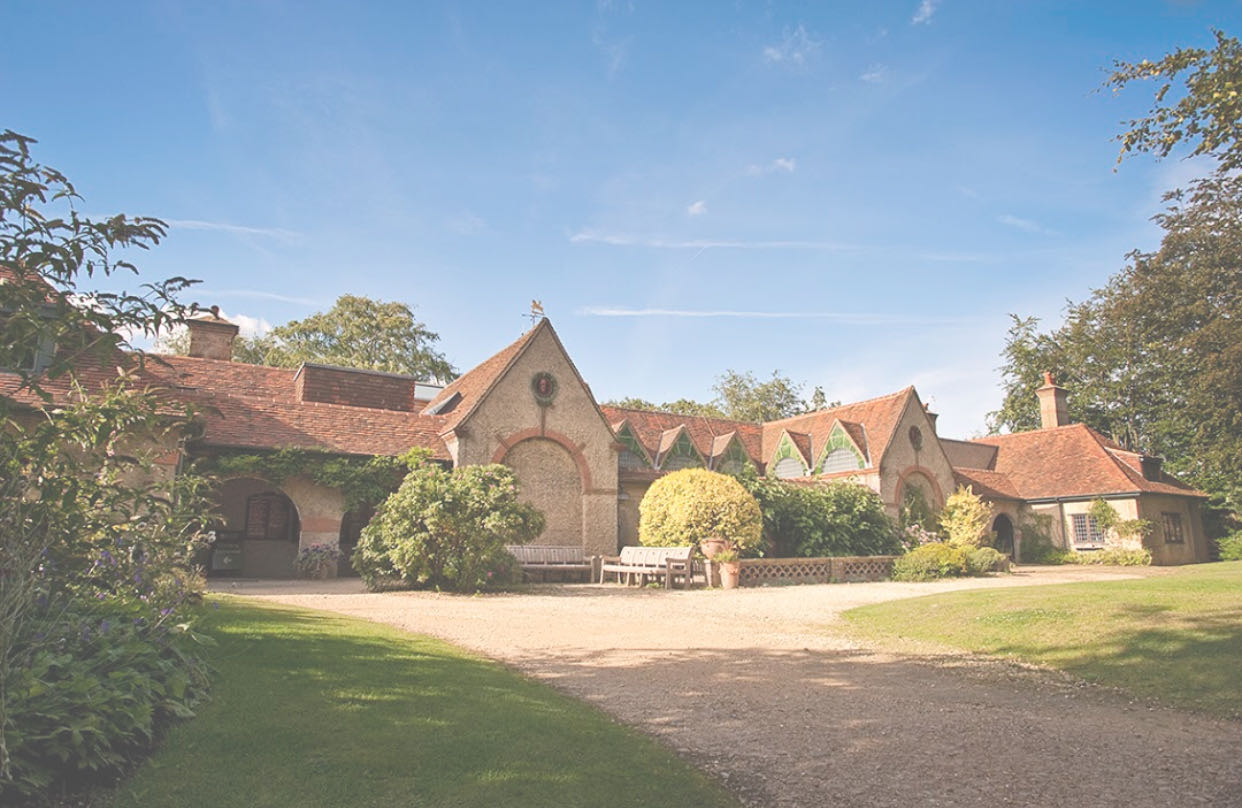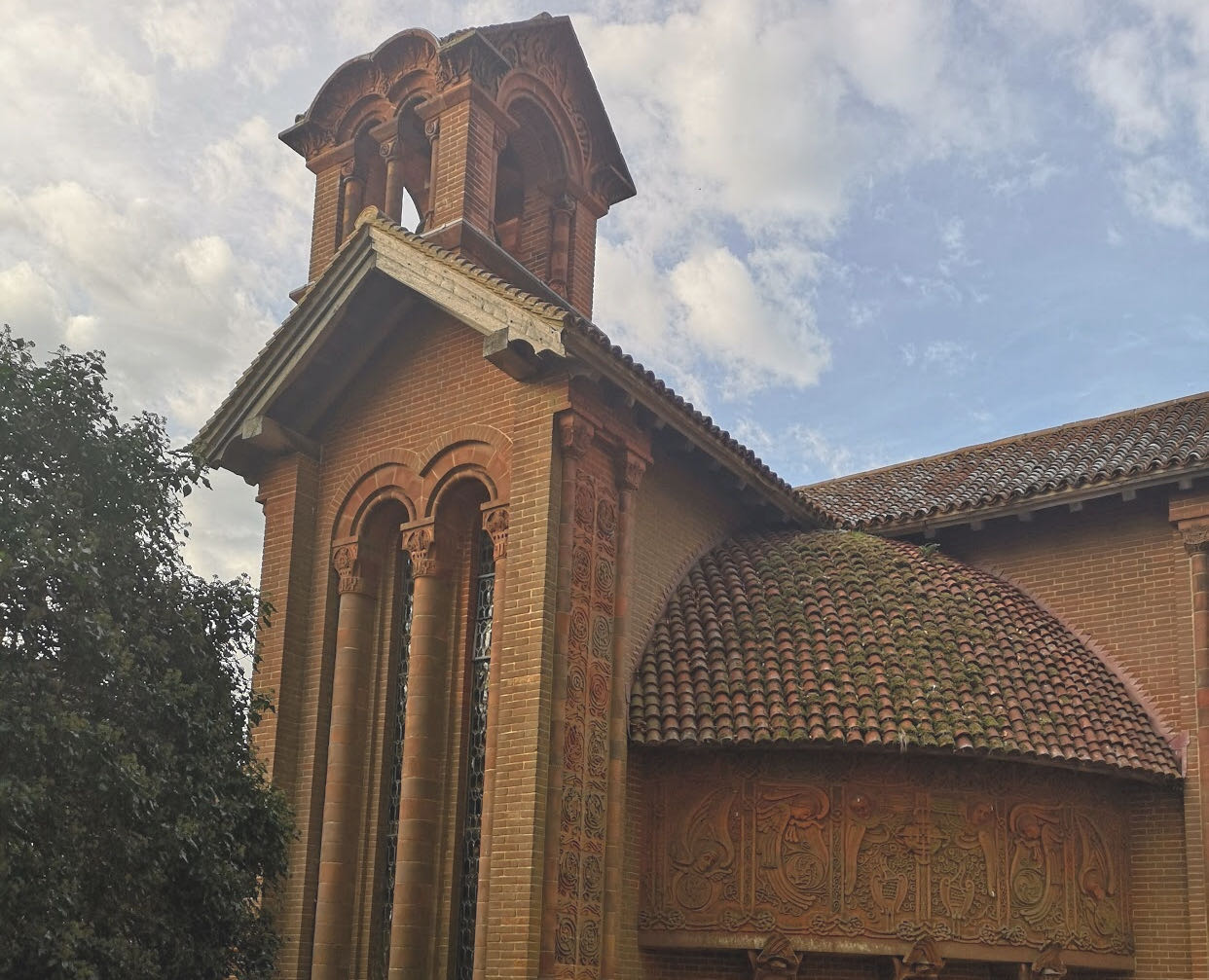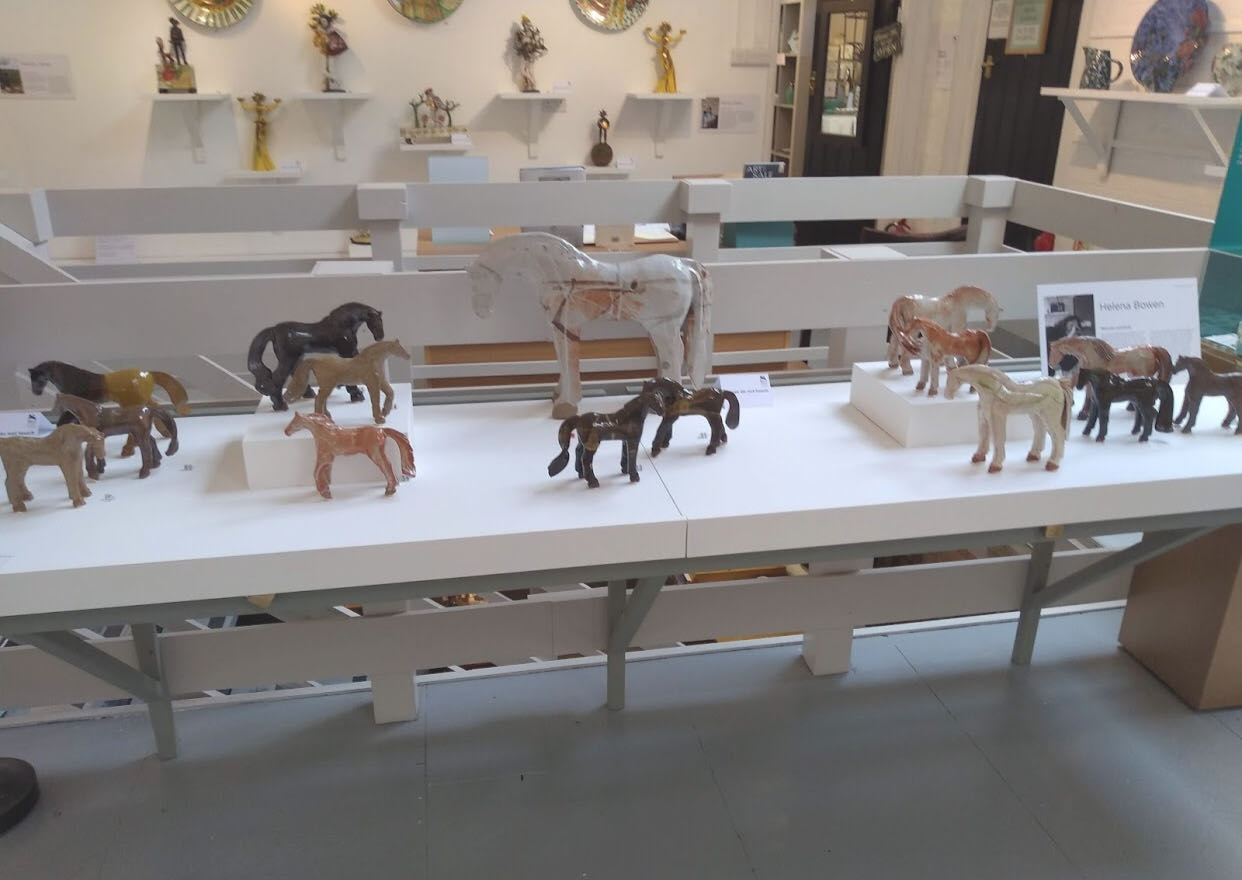
不光有优美的自然田园风光,萨里郡和吉尔福德同时也充满的浓郁的艺术气息,这一期博客,我带大家来参观下位于市镇西南的瓦茨美术馆-艺术家村Watts Gallery-Artists’ village。
整体来说,这是一个包含以雕塑、绘画作品为主,同时蕴藏着很多建筑设计元素的展览馆。馆区面积不大,但内部陈设装修精致考究,院落花园修造的色彩艳丽、层次分明。展览馆本身是12磅的门票,但如果进入其他场所,你必须要分开买票,教堂门票是5磅,如果你想要进入旁边的艺术家居,所需花费也是5磅,需要注意的是,这是一张有时间限制的票券。整体感觉这里的门票有点贵,听工作人员说,这里是由彩票机构赞助支持的,所以相比于别的旅游景点收费会略微高昂一些。
Watts Gallery – Artists’ Village is an art gallery in the village of Compton, near Guildford in Surrey. It is dedicated to the work of the Victorian-era painter and sculptor George Frederic Watts.
The gallery has been Grade II* listed on the National Heritage List for England since June 1975.

Overall, Watts Gallery is an interesting collection about sculptures and paintings in a period building, including some fantastic architecture elements as well. The gallery itself is not that so big but internal decoration is absolutely fabulous, together with the charming outside garden area, can getting visitors really enjoy every second here. Please make sure to see the studio next to the old house gallery. You need to buy ticket to get access to each attraction, Main gallery need 12 pounds to enter, the ticket for little chapel is 5 pounds. If you expect to view the internal space of the house where the artists living now, you need to buy a 5 pounds worth timed ticked. Bear in mind, you will need to ask for the ticket, because the information wasn’t on counter display when I visited. The staff told us there were no concessionary discounts for OAPs etc and this place is basically lottery funded.
展览室里,来自我们的主角-乔治·弗雷德里克·沃茨(George Frederick Watts)的绘画和雕塑就占了很大一部分比重,作品精致,与环境相得益彰,令人赞叹。除此外,还有相对不太知名的Evelyn de Morgan的绘画作品被用作展览馆旁Mary Watts教堂,看上去也是非常的精致与和谐。教堂由一位女士设计,一充满活力的色彩搭配艺术和手工艺品装饰。其中据说,这些手工艺品是由当时60余位村民制作装饰而成。整体来说,展览馆的场地布置典雅简约,当你游玩感觉累了,还可以在展览馆里的咖啡厅坐一会儿,这里提供食物饮品。除此外,这里还有一个小型茶室和礼品店,偶尔客人可以在这里得到参加艺术讲习班的机会。
In the main gallery, G.F.Watts’s masterpieces take up a large part of the display with paintings and sculptures. Underrated Evelyn de Morgan’s paintings can also be found to decorate the Mary Watts chapel. The little chapel designed by a lady and decorated in arts and crafts style in aspiring and vibrant colors, and all these works done by 60 village residents in over 100 years ago. Generally the layout here is classy, when you getting tired of tour, a little tea house and store can provide you with a place to sit down, where occasionally hold some art workshops for the public.

建筑外形
这里主要来讲一下画廊和主建筑,它们由克里斯托弗·特纳(Christopher Turner)于1903-1904年建造,这里在铺有瓷砖的毛坯砌面在边缘敷料上,展示了大量乔治·弗雷德里克·沃茨(George Frederick Watts)的绘画和雕塑。从内外构造来看,平坦的瓷砖屋顶,向右端倾斜,平放在中央走廊上方。中央廊厅由半个H形部分包围,廊厅终端则有L形范围到两边-通过两个拱形凉廊连接到主要场地。建筑的边侧有两层楼高,中间部分则只有加高的单层,由方形的石柱撑起,并且在边缘装饰有精美的瓷砖。由圆拱构成的廊道,其边缘上也铺有精美的装饰性瓷砖,并与中心的山墙相连。总体而言,建筑的设计非常集约简介而又不失精美大方。
The structure and landscape
Gallery and house. Built 1903-4 by Christopher Turner to contain the paintings and sculpture of George Frederick Watts. Roughcast cladding with tile on edge dressings. Plain tiled roofs, hipped to right end, flat over central gallery. Central gallery enclosed by half H-shaped portion with gable ends to south, L-shaped ranges to ends – connected to main range by two arched loggias. Two storeys to ends and one storey to centre. Corbelled square stacks with tile on edge decoration to tops on rear left and rear right of right hand wing. Casement fenestration leaded to right. One first floor window to each end, two ground floor windows to left, and one to right. Round arched loggias with tile on edge impost blocks connecting to gables either side of centre. Round arched panels to ground floor of gabled bay, with tile on edge keystones linking with roundels above. Over and around central flat roof are eight small gables containing lunette windows, two facing east, four facing south and two facing west. Doors to curator’s house on east end behind loggia and to gallery on west end behind identical loggia.

瓦茨美术馆的历史背景
艺术家瓦茨于1891年搬到康普顿的“ Limnerslease”,并与他同为艺术家的妻子玛丽·弗雷泽·泰特勒(Mary Fraser-Tytler)计划开建一个致力于展示他的作品的博物馆。博物馆最终于1904年4月在他去世前开幕。
画廊的建筑师是克里斯托弗·哈顿·特纳(Christopher Hatton Turnor),他是埃德温·卢滕斯(Edwin Lutyens)和C.F.A. Voysey。受那个时代手工艺运动的启发,该建筑包含顶灯画廊,使瓦茨的作品可以在经过滤的柔和的自然光线下展示。
瓦茨美术馆是英国仅有的几家专门致力于单一艺术家的画廊之一,并且经常被誉为村庄中心的国家美术馆。现任运营总监是Alistair Burtenshaw,策展人是Cicely Robinson博士。
当然,上镜的机会也是必不可少的,瓦茨美术馆在2006年的BBC电视连续剧《复原村》的决赛中排名第二,实至名归。

2008年1月,画廊宣布打算拆除和出售两幅维多利亚时代的画作,阿尔伯特·约瑟夫·摩尔于1880年创作的《睡着的女人》和爱德华·伯恩·琼斯于1871年创作的爱的胜利,这两幅画都被塞西尔出售给来自法国的收藏家。这笔款项后来被用于2008年9月至2010年美术馆的修复工作。
2006年12月,在BBC节目中名声大噪后,瓦茨美术馆迎来了又一个黄金发展期,它从遗产彩票基金会(Heritage Lottery Fund)获得了430万英镑的拨款用于翻新和装修工程,用以开发旅游市场的潜力和保护建筑物及其收藏品的目的。经多次翻修,瓦茨画廊于2011年6月重新开放,参观者现在可以在历史悠久的美术馆中体验展示原始装饰版本的Watts藏品。
画廊永久陈列着一百多幅G. F. Watts的画作。它们跨越了70年的沧桑历史,见证着伟大的事时代风云变迁。其中包括肖像画,风景画和其他一些主要象征性作品。从利瓦诺斯美术馆(Livanos Gallery)的戏剧性入口到雕塑博物馆(Sculpture Gallery)中的纪念性雕塑和工作室手工艺品,瓦茨美术馆(Watts Gallery)展示了艺术家留下的伟大精神遗产。
展览馆的规模在不断扩大,自2016年1月,Watts Gallery开设了新装修的“ Limnerslease”,这是G. F.和Mary Watts的故居和工作室,并完成了Artists’Village。所以自此以后,瓦茨艺术馆常常和“艺术家村”被一起标注。
康普顿的墓地就在附近,里面存放着瓦茨的遗骸,由瓦茨的夫人玛丽(Mary)所设计的华丽的瓦特太平间教堂(Wats Mortuary Chapel)委员会所管理,该博物馆也由其经营。

Historical background of Watts Gallery
Watts moved to “Limnerslease” in Compton in 1891, and with his artist wife, Mary Fraser-Tytler, planned a museum devoted to his work, which opened in April 1904, just before his death.
The architect of the Gallery was Christopher Hatton Turnor, an admirer of Edwin Lutyens and C.F.A. Voysey. Inspired by the Arts and Crafts movement, the building contains top-lit galleries that allow Watts’s work to be displayed under natural light.
It is one of only a few galleries in the UK devoted to a single artist, and is often hailed as a national gallery in the heart of a village. The present director is Alistair Burtenshaw and the curator is Dr Cicely Robinson。 Former curators include Dr Nicholas Tromans, Wilfrid Blunt, Richard Jefferies and Mark Bills. Watts Gallery is a registered charity under English law.
Watts Gallery was placed second in the final of the BBC TV series Restoration Village in 2006.

In January 2008 it was announced that the Gallery intended to deaccession and sell two Victorian paintings, Sleeping Woman (1880) by Albert Joseph Moore and Triumph of Love (1871) by Edward Burne-Jones, which had both been bequeathed to the collection by Cecil French. These were duly sold. The money was used to maintain the Gallery which was closed from September 2008 until 2010 for restoration.
In December 2006 Watts Gallery received a £4.3 million grant from the Heritage Lottery Fund for renovations to help safeguard the future of the building and its collections.
Watts Gallery reopened in June 2011 after a major scheme of works, including extension, refurbishment and restoration. Visitors can now experience the Watts collection in the historic galleries displaying the original decorative schemes.

Over one-hundred paintings by G. F. Watts are on permanent display at the Gallery. Spanning a period of 70 years they include portraits, landscapes and his major symbolic works. From the dramatic entrance of the Livanos Gallery to the monumental sculpture and studio artefacts in the Sculpture Gallery, Watts Gallery shows the collection left by the artist as his legacy.
In January 2016, Watts Gallery opened the newly-renovated “Limnerslease”, the former home and studio of G. F. and Mary Watts, completing the Artists’ Village.
Compton’s burial ground, nearby, houses Watts’ remains and is dominated by the ornate Arts & Crafts Watts Mortuary Chapel, designed by Watts’ wife Mary, also run by the museum.
